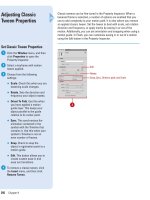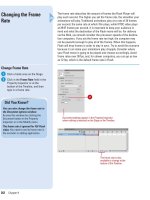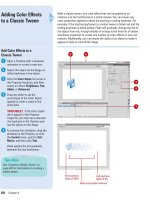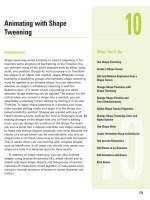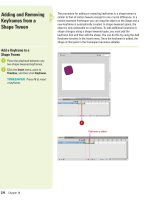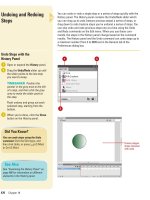Tài liệu Thiết kế flash với flash cs5 part 36 docx
Bạn đang xem bản rút gọn của tài liệu. Xem và tải ngay bản đầy đủ của tài liệu tại đây (718.66 KB, 9 trang )
ptg
Animating with Motion
Tweening
8
8
What You’ll Do
Understand Motion Tweening
Apply Motion Tween Presets
Create a Motion Tween
Adjust Motion Tween Properties
Edit Motion Tween Properties with
the Motion Editor
Add Color Effects and Filters
Work with Property Keyframes
Edit the Path of a Motion Tween
Copy Motion as ActionScript
237
Introduction
In Flash, it’s not necessary to draw every frame of an anima-
tion. You can set the position and attributes of your art in the
beginning and ending frames, and Flash will create all of the
frames in between. This is called
tweening
. A motion tween
connects two keyframes, each with different effects or charac-
teristics applied to them and then gradually "morphs" one
into the other. Tweening allows you to quickly animate
objects, apply fades, and gradually alter color, alpha, scale,
and any other effect that can be applied to a symbol, group,
or text object.
The span between the starting frame and ending frame of
a motion tween is called the
tween span
. The tween span
consists of a group of frames in a single layer with a blue
background in the Timeline in which an object changes over
time. Only one object, known as the
target object
, on the
Stage can be animated in each tween span.
Once an animation is tweened, you can continue to edit it
by adding or removing frames to make it move slower or
faster, adjust effects, or control the inertia with ease-in and
ease-out properties, adding further complexity. Motion
tweening produces smaller files than frame-by-frame anima-
tion because Flash describes the motion mathematically,
incrementally transforming the object in between the two
keyframes.
From the Library of Wow! eBook
ptg
238
Chapter 8
Motion tweening allows you to apply smooth
motion and transform effects, such as scale,
position, rotation, and skew, to symbol
instances (movie clip, graphic, and button)
and text fields. Additionally, you can utilize
Flash's advanced color effects to apply
changes to color, alpha, and brightness.
Because these effects are applied to
instances, they only affect the instance placed
on the Stage. Its parent (original) symbol in
the Library is not affected. Motion tweening
produces the smallest file sizes of any of
Flash's animation methods.
Flash use two different types of motion
tweens:
classic tween
and
motion tween
. A
classic tween uses several instances in
keyframes of an object along with property
keyframes to create a tween, while a motion
tween uses one object instance over the entire
span along with property keyframes to create
a tween. A property keyframe is a frame
within the motion tween where you define a
value for a property. A motion tween is known
as object based animation. Motion tweens are
easy to create and provide precise control,
while classic tweens are more complex to cre-
ate and provide more advanced control. All
motion tweens from Flash CS3 are classic
tweens.
Tween Differences
There are several differences between classic
and motion tweens.
Classic Tweens
◆
Use Keyframes and property keyframes
to create tweens.
◆
Allow frame scripts.
Understanding Motion Tweening
◆
Allow only symbols (movie clip, graphic,
and button) as a tweenable type. It
converts all others (editable shapes,
groups, and text objects) to a graphic
symbol.
◆
Consist of groups of individually
selectable frames in the Timeline.
◆
Apply eases to groups of frames
between keyframes within the tween.
◆
Allow animation between two different
color effects, such as tint and alpha
transparency.
◆
Don’t allow animation of 3D objects.
◆
Allow symbol swaps and setting the
frame number of a graphic symbol to
display in a property keyframe.
Motion Tweens
◆
Use one object instance and property
keyframes instead of keyframes to create
tweens.
◆
Don’t allow frame scripts.
◆
Allow text as a tweenable type. It doesn’t
convert it to a symbol.
◆
Treat tween sp ans as a sing le obje ct that
you can stretch and resize in the
Timeline.
◆
Apply eases across the entire length of a
motion tween span.
◆
Apply only one color effect per tween.
◆
Allow animation of 3D objects.
◆
Don’t allow symbol swaps and setting
the frame number of a graphic symbol to
display in a property keyframe.
◆
Convert all non-allowed object types
(editable shapes and groups) to a movie
clip symbol.
From the Library of Wow! eBook
ptg
Chapter 8 Animating with Motion Tweening
239
Motion tweening when viewed in
Onion Skin/Multiple Frames mode
Motion tweening when viewed in
Onion Skin/Multiple Frames mode
Motion Tweening of Scale and Alpha Changes
Motion Tweening of Scale, Alpha, and Rotation Changes
From the Library of Wow! eBook
ptg
240
Chapter 8
Motion Presets are ready-made motion tweens that you can apply to
an object on the Stage. After you preview a motion tween in the
Motion Presets panel, you can quickly apply it to a selected object. You
can apply only one motion preset per object on the Stage. If you apply
another preset to an object, it replaces the previous one. You can only
apply a 3D motion preset to a movie clip instance, which is the only
object type for 3D effects. Each motion preset contains a specific
number of frames, which you can adjust later. In the Motion Presets
panel, you can also create and save your own custom motion presets
as well as import and export them (stored as XML files) to share with
others.
Applying Motion
Tween Presets
Apply a Motion Tween Preset
Select a tweenable object (symbol
instance or text field) on the Stage.
Click the Window menu, and then
click Motion Presets to open the
panel.
Select a preset in the Motion
Presets panel.
A preview of the preset plays in
the Preview pane at the top of the
Motion Presets panel.
◆
To stop the preview, click
outside the Motion Presets
panel.
Click Apply.
◆
If you apply a motion tween to
a non-tweenable object, a
dialog box appears, asking you
to convert it to a symbol.
The motion is set to start at the
current position of the object on
the Stage.
◆
To apply the preset so that the
motion ends at the current
position of the object on the
Stage, hold down Shift, and
then click Apply.
4
3
2
1
4
1
3
2
Preview pane
From the Library of Wow! eBook
ptg
Chapter 8 Animating with Motion Tweening
241
Save a Tween as a Custom
Motion Preset
Select the tween span, object on
the Stage, or the motion path on
the Stage with the custom tween
that you want to save as a preset.
Click the Window menu, and then
click Motion Presets to open the
panel.
Click the Save Selection As Preset
button.
Type a name for the preset.
Click OK.
The new preset appears in the
Motion Presets panel under
Custom Presets. The preset is
saved as an XML file in the Motion
Presets folder, which you can
locate by performing a search
using Instant Search (Win) or
Spotlight (Mac).
◆
To create a preview for the new
preset, publish a SWF of the
motion tween with the same
name in the Motion Presets
folder.
5
4
3
2
1
Did You Know?
You can import and export a motion
preset.
To import a motion preset, click
the Options button on the Motion
Presets panel, click Import, select the
XML file, and then click Open. To
export a motion preset, select the pre-
set in the Motion Presets panel, click
the Options button, click Export, spec-
ify a name and location, and then click
Save.
You can delete a motion preset.
Select
the motion preset in the Motion
Presets panel that you want to delete,
and then click the Remove Item button.
3
2
4
1
5
From the Library of Wow! eBook



